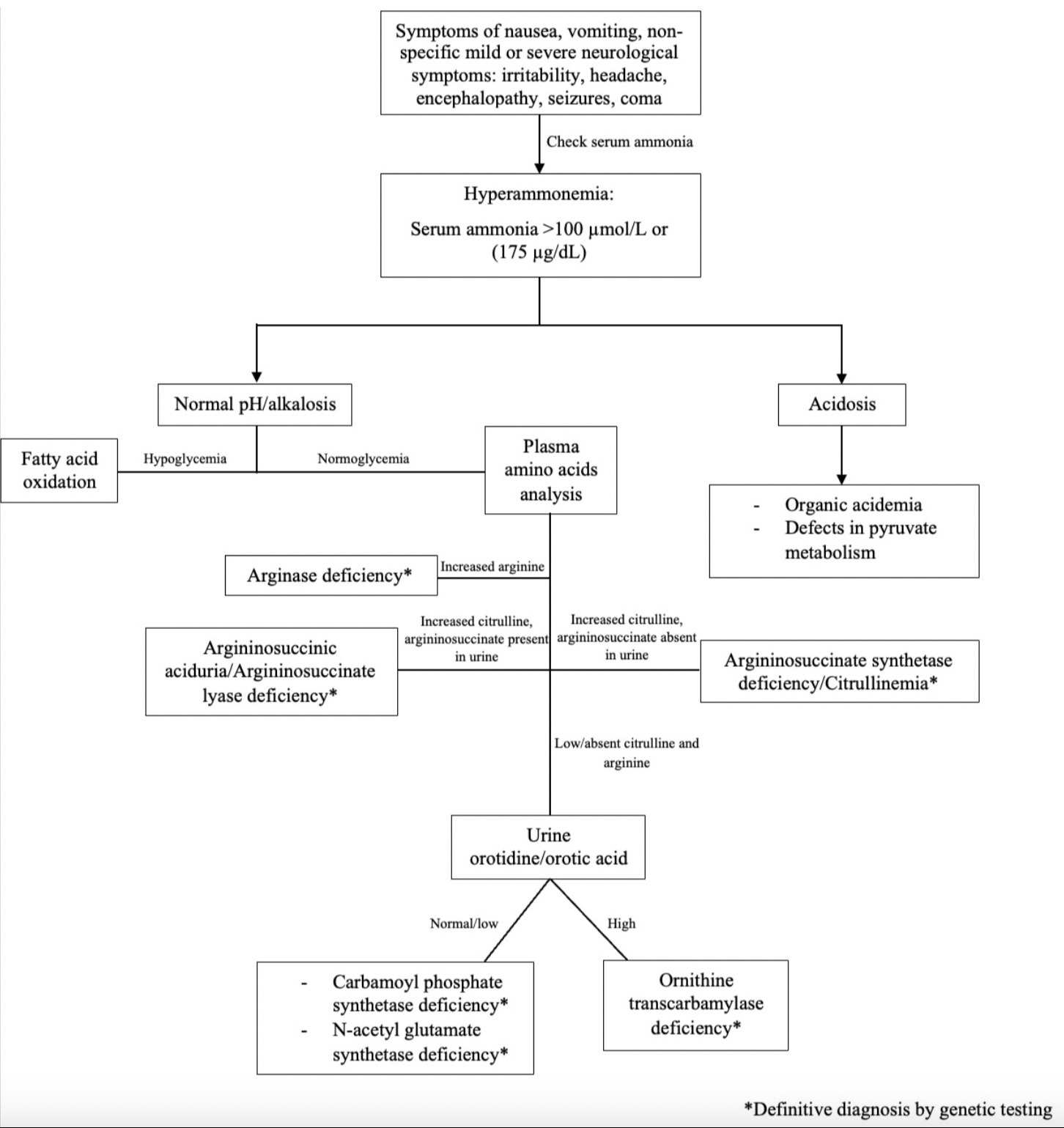Tuesday Poster Session
Category: Liver
P4765 - Familial Hyperammonemia Requiring Liver Transplantation: A Case Series of Type 1 Citrullinemia
Tuesday, October 29, 2024
10:30 AM - 4:00 PM ET
Location: Exhibit Hall E

Has Audio

Zehra Naseem, MD
Cleveland Clinic
Cleveland, OH
Presenting Author(s)
Zehra Naseem, MD, Amala J Alenchery, MD, Kadakkal Radhakrishnan, MD, Sobia Laique, MD
Cleveland Clinic, Cleveland, OH
Introduction: Symptomatic hyperammonemia is typically associated with liver cirrhosis but may originate from metabolic conditions like urea cycle disorders (UCDs), necessitating a robust diagnostic approach (Figure 1). We explore hyperammonemia from type 1 citrullinemia, detailing the experiences of four siblings who underwent orthotopic liver transplantation (LT) at our institution.
Case Description/Methods: Case 1: Male patient diagnosed at age 6 due to learning difficulties, vomiting, and lethargy, progressed to recurrent seizures by age 14. MRI brain showed bi-frontal encephalomalacia with ventricular enlargement. Despite adherence to ammonia scavenging medications, he experienced multiple hyperammonemia crises. He underwent OLT at 28 years of age but continued to have seizures post-transplant, highlighting the irreversible neurological effects of citrullinemia.
Case 2: Male patient diagnosed at ten days of age and managed with medications. By age 9, he experienced several hyperammonemic crisis, below-average growth, and learning challenges. A successful OLT at 22 years of age improved his growth parameters.
Case 3: Female patient diagnosed at week one of life, managed medically and with dietary interventions. She underwent OLT at age 20 for hyperammonemic crises and continued to do well post-transplant.
Case 4: Female neonate diagnosed shortly after birth and medically managed. Despite normal milestones, her physical growth remained below the 5th percentile. An OLT at age 11 helped her reach appropriate growth rates for her age.
Discussion: UCDs have an estimated US incidence of 1/35,000 births, mostly presenting in the neonatal period. Early screening and diagnosis are imperative to good outcomes with high index of suspicion for milder phenotypes which present later in life. UCDs are managed long term with protein restrictions, ammonia-scavenging medications, LT, and evolving liver directed gene therapy. While medical management reduces the frequency of hyperammonemic crises, it does not completely prevent them. LT is potentially curative and most effective when performed early in patients with recurrent metabolic issues, those failing medical therapies, or those with poor healthcare access. Despite LT's comparable survival rates to medical management, it poses surgical and immunosuppressive risks. Unfortunately, neither strategy can reverse existing neurological damage, underscoring the importance of early diagnosis and a multidisciplinary approach to effectively manage these challenging disorders.

Disclosures:
Zehra Naseem, MD, Amala J Alenchery, MD, Kadakkal Radhakrishnan, MD, Sobia Laique, MD. P4765 - Familial Hyperammonemia Requiring Liver Transplantation: A Case Series of Type 1 Citrullinemia, ACG 2024 Annual Scientific Meeting Abstracts. Philadelphia, PA: American College of Gastroenterology.
Cleveland Clinic, Cleveland, OH
Introduction: Symptomatic hyperammonemia is typically associated with liver cirrhosis but may originate from metabolic conditions like urea cycle disorders (UCDs), necessitating a robust diagnostic approach (Figure 1). We explore hyperammonemia from type 1 citrullinemia, detailing the experiences of four siblings who underwent orthotopic liver transplantation (LT) at our institution.
Case Description/Methods: Case 1: Male patient diagnosed at age 6 due to learning difficulties, vomiting, and lethargy, progressed to recurrent seizures by age 14. MRI brain showed bi-frontal encephalomalacia with ventricular enlargement. Despite adherence to ammonia scavenging medications, he experienced multiple hyperammonemia crises. He underwent OLT at 28 years of age but continued to have seizures post-transplant, highlighting the irreversible neurological effects of citrullinemia.
Case 2: Male patient diagnosed at ten days of age and managed with medications. By age 9, he experienced several hyperammonemic crisis, below-average growth, and learning challenges. A successful OLT at 22 years of age improved his growth parameters.
Case 3: Female patient diagnosed at week one of life, managed medically and with dietary interventions. She underwent OLT at age 20 for hyperammonemic crises and continued to do well post-transplant.
Case 4: Female neonate diagnosed shortly after birth and medically managed. Despite normal milestones, her physical growth remained below the 5th percentile. An OLT at age 11 helped her reach appropriate growth rates for her age.
Discussion: UCDs have an estimated US incidence of 1/35,000 births, mostly presenting in the neonatal period. Early screening and diagnosis are imperative to good outcomes with high index of suspicion for milder phenotypes which present later in life. UCDs are managed long term with protein restrictions, ammonia-scavenging medications, LT, and evolving liver directed gene therapy. While medical management reduces the frequency of hyperammonemic crises, it does not completely prevent them. LT is potentially curative and most effective when performed early in patients with recurrent metabolic issues, those failing medical therapies, or those with poor healthcare access. Despite LT's comparable survival rates to medical management, it poses surgical and immunosuppressive risks. Unfortunately, neither strategy can reverse existing neurological damage, underscoring the importance of early diagnosis and a multidisciplinary approach to effectively manage these challenging disorders.

Figure: Diagnostic algorithm for diagnosis of urea cycle disorders
Disclosures:
Zehra Naseem indicated no relevant financial relationships.
Amala J Alenchery indicated no relevant financial relationships.
Kadakkal Radhakrishnan indicated no relevant financial relationships.
Sobia Laique indicated no relevant financial relationships.
Zehra Naseem, MD, Amala J Alenchery, MD, Kadakkal Radhakrishnan, MD, Sobia Laique, MD. P4765 - Familial Hyperammonemia Requiring Liver Transplantation: A Case Series of Type 1 Citrullinemia, ACG 2024 Annual Scientific Meeting Abstracts. Philadelphia, PA: American College of Gastroenterology.
